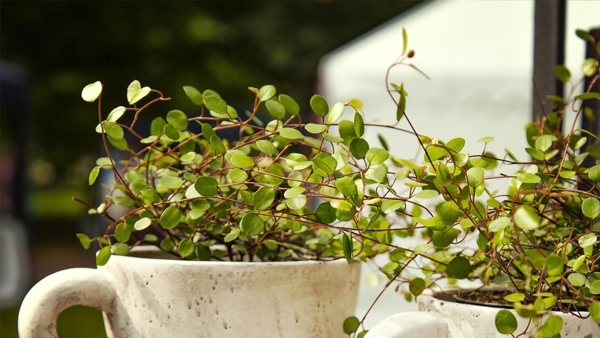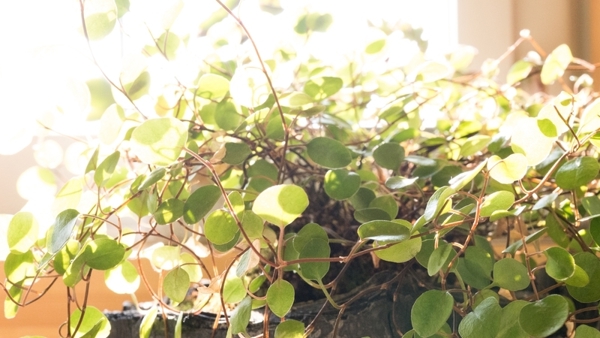Yates Account
Join now
Create a Yates account today!
Sign up to join the Yates Garden Club for monthly e-mails packed with seasonal inspiration, tips for success & exclusive promotions.
Plus if you’re a Garden Club member you can take part in the Yates Growing Community - a blog to share successes, get advice & win prizes in fun challenges along the way!

Forgot password
Enter the email address associated with your account, and we'll email you a new password.

Wire Vine (Muehlenbeckia spp.) is a very versatile perennial plant. It is a climber with twining reddish stems and small round leaves. It can be used as a groundcover and is also a popular plant choice for small size topiary. Muehlenbechia can be used as a low border with regular pruning and looks great in rockeries, or even used in a hanging basket. Its leaves resemble a maidenhair fern and is often referred to as the Maidenhair climber.
How to grow wire vine in a garden
- Choose a sunny or shady spot with well-drained soil. This versatile plant will grow almost anywhere. Enrich the soil with Yates Thrive Natural Blood & Bone with Seaweed. If the soil is heavy or clay-based, add gypsum and fork in well.
- Dig the planting hole twice as wide and to the same depth as the root-ball. Remove the shrub from the container, gently tease the roots and cut away any circled or tangled roots.
- Position in hole and backfill with soil, gently firming down.
- Form a raised or doughnut-shaped ring of soil around the outer edge of the plant's root zone. This helps keep water where it's needed. Always water in well after planting to settle the soil around the roots and keep the soil moist for several weeks while the new plant establishes.
- Mulch around the base with organic mulch like bark chips, woodchip or pea straw, keeping it away from the base of the plant.
- Water deeply once or twice a week during establishing, but little extra watering is required once established.
- Feed every 6-8 weeks from spring to autumn with Yates Thrive All Purpose Granular Plant Food. Growth will slow dramatically in the cooler months. TIP: For an added boost, apply Yates Thrive Natural Fish & Seaweed+ Plant Food Concentrate during the growing season.


How to grow wire vine in a pot
- Choose a pot 200 mm wide and deep, or larger if using as a topiary. Position in full sun or shade.
- Fill chosen pot with quality potting mix, such as Yates Premium Potting Mix. Remove the plant from the container, gently tease the roots and cut away any circled or tangled roots.
- Position in hole and backfill with potting mix, gently firming down. Water in well.
- Water deeply, and then once or twice a week, depending on weather conditions.
- Feed regularly during the growing season with Yates Thrive All Purpose Liquid Plant Food. TIP: For an added boost, apply Yates Thrive Natural Fish & Seaweed+ Plant Food Concentrate.
Growing tips
- Prune in spring to help promote new growth.
- Regular pruning during active growing season to control the rapid growth during warmer month.
- A vigorous grower when the weather is warm, this attractive plant can smother slower/small plants if grown in close proximity or not trained/pruned as a topiary.
- Can grow in full sun to full shade in cold to sub-tropical areas.
- Dry tolerant once established.
Orange trumpet vine, with its brilliant cascading masses of orange tubular flowers, is one of the most spectacular winter flowering climbers.
Spring Stars
Spring Stars are a versatile addition to any garden with delightful lavender-blue, star shaped blooms.
Flax
Flaxes (Phormium spp.) are highly versatile plants which don't mind swampy or dry conditions. Great for large pots or planted en-masse in garden beds.
Proteas
Not just any old blossom, protea flowers are blooms with attitude. If you can give them full sun and reasonable drainage, proteas will love you.
Recommended products
Yates Dynamic Lifter Organic Plant Food
Releases nutrients slowly, improves the structure and moisture retention of the soil and encourages earthworms and beneficial soil micro-organisms.
Yates Thrive All Purpose Granular Plant Food
Easy-to-use granular plant food specially formulated with both fast acting and gradual feeding for up to 3 months, in the garden or pots.
Yates Premium Potting Mix
A premium potting mix, ideal for all potted plants and shrubs, including ornamentals, fruit trees, vegies and herbs.
Yates Thrive Natural Fish & Seaweed+ Plant Food Concentrate
A complete plant food enriched with natural fish, seaweed, humates, molasses and more - boosted with NPK to improve plant and soil vitality.
















Share
Share this article on social media